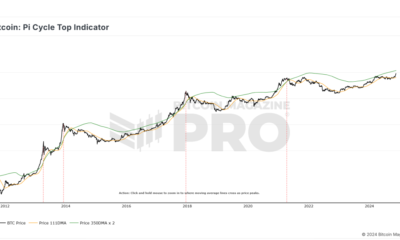crypto assets
Trump’s lead over Harris is growing
Published
3 months agoon
By
admin

Donald Trump has widened his lead over Kamala Harris on Polymarket as the 2024 U.S. presidential election approaches.
After a period of near parity in mid-August, Trump’s odds on Polymarket have surged several percentage points, with 53% of bettors favoring him compared to 47% for Harris.
This shift marks a comeback for Donald Trump, whose odds dipped after Joe Biden announced he wouldn’t seek re-election, resulting in a temporary boost for the current Vice President.
Trump is growing his lead on Polymarket…
The regular interviews and podcasts are creating a sharp distinction between Kamala who refuses to speak off script. https://t.co/bRCliCfiQb
— Geiger Capital (@Geiger_Capital) September 4, 2024
Despite the rise to 53%, Trump’s chances are much lower than the 72% peak following the Bitcoin 2024 conference in late July in Nashville, Texas.
Trump and crypto
Trump’s resurgence can in part be attributed to his strong appeal among crypto investors, a demographic increasingly influential in this election, according to Coinbase.
His pro-crypto stance, including promises to support the Bitcoin (BTC) sector and blockchain initiatives, has resonated with crypto heavyweights.
On Aug. 27, Trump announced announced his fourth NFT collection, “Series 4: The America First Collection,” offering digital trading cards via Bitcoin Ordinals. Two days later, he announced plans to make the U.S. the “crypto capital of the planet” if re-elected, referencing his initiative, World Liberty Financial.
On the other hand, Harris’s campaign has struggled to maintain momentum among Polymarket users, particularly after key events like the Democratic National Convention, where crypto was notably absent from the discourse.
During this election season, both parties have catered to the crypto crowd, aiming to appeal to the crypto community and its financial contributions. As a result, Polymarket election bettors have been on quite the ride, and it’s expected that things will only get crazier as election season approaches.
Source link
You may like


How Viable Are BitVM Based Pegs?


UK Government to Draft a Regulatory Framework for Crypto, Stablecoins, Staking in Early 2025


Bitcoin Cash eyes 18% rally


Rare Shiba Inu Price Patterns Hint SHIB Could Double Soon


The Bitcoin Pi Cycle Top Indicator: How to Accurately Time Market Cycle Peaks


Bitcoin Approaches $100K; Retail Investors Stay Steady

Bitcoin Cash (BCH) added nearly 35% to its value in the past month and rallied 12% on Nov. 21. Bitcoin’s (BTC) observed a rally to $98,384 early on Nov. 21, with BCH and other top cryptocurrencies tagging along for the ride.
An analysis of on-chain and technical indicators and data from the derivatives market shows that BCH could extend gains and retest its mid-April 2024 peak of $569.10.
Bitcoin hits all-time high, fork from 2017 ignites hope for traders
Bitcoin hit a record high of $98,384 on Nov. 21, a key milestone as the cryptocurrency eyes a run to the $100,000 target. BTC was forked in 2017, creating a spin-off or alternative, Bitcoin Cash.
BCH hit a peak of $1,650 in May 2021. Since April 2024, BCH has been consolidating with no clear trend formation.
BCH price rallied nearly 30% since Nov. 15, on-chain indicators show that further rally is likely in the Bitcoin spin-off token.
Bitcoin Cash’s active addresses have climbed consistently since August 2024. Santiment data shows an uptrend in active addresses, meaning BCH traders have sustained demand for the token, supporting a bullish thesis for the cryptocurrency.
The ratio of daily on-chain transaction volume in profit to loss exceeds 2, is 2.141 on Thursday. BCH traded on-chain noted twice as many profitable transactions on the day, as the ones where losses were incurred. This is another key metric that paints a bullish picture for the token forked from Bitcoin.
Binance funding rate is positive since Nov. 10. In the past eleven days, traders have been optimistic about gains in BCH price, according to Santiment data.

The network realized profit/loss metric identifies the net gain or loss of all traders who traded the token within a 24 hour period. NPL metric for Bitcoin Cash shows traders have been taking profits on their holdings, small positive spikes on the daily price chart represent NPL.
Investors need to keep their eyes peeled for significant movements in NPL, large positive spikes imply heavy profit-taking activities that could increase selling pressure across exchange platforms.
84.48% of Bitcoin Cash’s supply is currently profitable, as of Nov. 21. This metric helps traders consider the likelihood of high profit-taking or exits from existing BCH holders, to time an entry/ exit in spot market trades.

Derivatives traders are bullish on BCH
Derivatives market data from Coinglass shows a 33% increase in open interest in Bitcoin Cash. Open interest represents the total number of active contracts that haven’t been settled, representing demand for the BCH token among derivatives traders.
Derivatives trade volume climbed 613% in the same timeframe, to $2.35 billion. Across exchanges, Binance and OKX, the long/short ratio is above 1, closer to 2, meaning traders remain bullish on BCH and expect prices to rally.

BCH futures open interest chart shows a steady increase in the metric, alongside BCH price gain since November 5, 2024. Open interest climbed from $190.74 million to $254.87 million between November 5 and 21.

Technical indicators show BCH could gain 18%
The BCH/USDT daily price chart on Tradingview.com shows that the token remains within the consolidation. The token is stuck within a range from $272.70 to $568.20. BCH could attempt to break past the upper boundary of the range, a daily candlestick close above $568.20 could confirm the bullish breakout.
The April 2024 high of $719.50 is the next major resistance for BCH and the second key level is at $805.80, a key level from May 2021.
The relative strength index reads 64, well below the “overvalued” zone above 70. RSI supports a bullish thesis for BCH. Another key momentum indicator, moving average convergence divergence flashes green histogram bars above the neutral line. This means BCH price trend has an underlying positive momentum.
The awesome oscillator is in agreement with the findings of RSI and MACD, all three technical indicators point at likelihood of gains.

A failure to close above the upper boundary of the range could invalidate the bullish thesis. BCH could find support at the midpoint of the range at $419.90 and the 50-day exponential moving average at $388.50.
Disclosure: This article does not represent investment advice. The content and materials featured on this page are for educational purposes only.
Source link
crypto assets
How many cryptocurrencies are there? Total number and types
Published
2 weeks agoon
November 7, 2024By
admin
The first cryptocurrency appeared in 2009, and today, its name is known by almost everyone — Bitcoin. What made it so intriguing was the promise of a new kind of money: no government interference, full privacy, and everyone having the same rights within the system.
At first, Bitcoin (BTC) was not taken seriously. It wasn’t until 2013, when its price passed a few hundred dollars, that the rise of cryptos really took off, and they began spreading and multiplying globally. So, how many cryptocurrencies are there today?
How many cryptocurrencies are in the world?
Statista reports that by September 2024, the number of cryptocurrencies is getting close to 10,000. However, it’s worth noting that many of these cryptocurrencies may not be particularly relevant or active.
Statista also notes that other sources estimate there are around 20,000 cryptocurrencies in existence, though most of these are either inactive or have been discontinued.
As of early November CoinMarketCap, a leading cryptocurrency data aggregator that tracks prices, market cap, and trading volume, lists 9,916 cryptocurrencies, while CoinGecko, another popular crypto data platform known for its comprehensive market statistics, shows 15,142.
Figuring out exactly how many cryptos there are is tricky, since the number keeps changing, but we can say this for sure: there are way more now than there were in 2009.
Why are there so many cryptocurrencies?
Thanks to easier access to blockchain technology, even those with basic coding knowledge can launch their own cryptocurrency. Platforms like Ethereum allow developers to create tokens without needing to build their own blockchain from scratch.
This low barrier to entry has led to an explosion of new projects, each claiming to offer something unique, whether it’s faster transactions, privacy features, or use in specific industries. Some even target niche markets like gaming, art, or supply chains.
While many of these coins won’t survive long-term, the ease of creation fuels constant experimentation and innovation, driving the evolution of the entire crypto ecosystem.
How many types of cryptocurrencies are there?
How many crypto are there?
With so many different types of cryptocurrencies, each designed for a specific goal, here’s a breakdown of the main categories.
Bitcoin and Bitcoin forks
Bitcoin is the first and most famous cryptocurrency, designed as a decentralized, peer-to-peer digital currency. Bitcoin forks like Bitcoin Cash (BCH) and Bitcoin SV (BSV) are versions of Bitcoin with minor adjustments to improve speed or transaction costs.
Altcoins
Altcoins are basically any cryptocurrencies that aren’t Bitcoin, each offering something unique, whether it’s new features, different uses, or fresh technology to shake up the digital currency scene. For example, Ethereum (ETH) brings smart contracts to the table, while Solana (SOL) stands out for its fast and low-cost transactions.
Stablecoins
Designed to reduce volatility, stablecoins are pegged to real-world assets like the US dollar. Tether (USDT) is the most widely used, offering stability for traders.
Meme coins
Meme coins like Dogecoin (DOGE) and Shiba Inu (SHIB) were created as fun projects but turned into something much bigger thanks to viral social media moments. Pepe Coin, inspired by the Pepe the Frog meme, has also become popular in the meme-crypto space.
Utility tokens
These tokens are used to power specific applications. Chainlink connects smart contracts to real-world data, while Uniswap is used for governance in the Uniswap decentralized exchange. Binance Coin started as a way to pay lower fees on the Binance exchange but now has broader uses across the Binance ecosystem.
How many cryptos are actually significant?
There are thousands of cryptocurrencies out there, but only a small percentage are truly significant, in terms of widespread use, market value, and technological impact. Bitcoin remains the dominant force, widely recognized as the first and most valuable cryptocurrency.
Ethereum is another heavyweight, known for its smart contract capabilities and dApps, driving much of the DeFi and NFT boom. Other notable cryptos include Binance Coin, which powers the Binance ecosystem, and Solana, praised for its high-speed transactions.
Meme coins, like Dogecoin and Shiba Inu, have certainly gotten attention, but whether they’ll have lasting value is still a big question. The crypto world is moving fast, but not many assets have truly changed the industry. The ones that have are still the ones leading in terms of innovation and market impact.
Source link
crypto assets
Florida has $800m in crypto-related holdings: CFO
Published
3 weeks agoon
October 31, 2024By
admin

Florida Chief Financial Officer Jimmy Patronis revealed that the state holds approximately $800 million in crypto-related investments as part of its portfolio, a position he discussed during a CNBC interview.
Patronis emphasized Florida’s commitment to exploring cryptocurrency as a viable investment, despite traditional concerns about its role in state retirement funds.
“Crypto is not going anywhere. It’s not going to contract. It’s going to continue to be expanding,” Patronis stated in the interview, expressing confidence in the technology’s long-term potential.
Patronis made it clear that he views cryptocurrency as an established asset class with substantial investment prospects.
“We have about $800 million in crypto-related investments in our state portfolio,” Patronis said in reference to Florida’s crypto holdings.
Florida isn’t the first U.S. state to dabble in crypto holdings. Wisconsin’s Investment Board had invested in the two largest spot Bitcoin (BTC) ETFs, holding 2.4 million shares of BlackRock’s iShares Bitcoin Trust worth nearly $99.1 million as of May 2024. Additionally, a U.S. SEC filing revealed that the state-owned over 1 million shares of Grayscale’s GBTC, valued at more than $63.3 million at the end of March.
Other states like Ohio and Pennsylvania have pushed pro-crypto legislation as well.
Florida and crypto regulation
The interview also covered regulatory concerns. Patronis discussed Florida’s approach to crypto regulation, particularly regarding national issues like the potential implementation of a central bank digital currency.
He expressed concerns about possible federal overreach with a centralized digital currency, emphasizing that cryptocurrency offers an alternative for preserving purchasing power amid inflationary pressures.
Patronis outlined a broader vision to position Florida at the forefront of the crypto landscape, with the aim of making Miami a key global crypto hub.
Source link

How Viable Are BitVM Based Pegs?

UK Government to Draft a Regulatory Framework for Crypto, Stablecoins, Staking in Early 2025

Bitcoin Cash eyes 18% rally

Rare Shiba Inu Price Patterns Hint SHIB Could Double Soon

The Bitcoin Pi Cycle Top Indicator: How to Accurately Time Market Cycle Peaks
Bitcoin Breakout At $93,257 Barrier Fuels Bullish Optimism

Bitcoin Approaches $100K; Retail Investors Stay Steady

Solana Hits New ATH On Huge Whale Accumulation, More Gains Ahead?

Microsoft Should Buy $78 Billion Worth of Bitcoin

Ethereum Believers May Be Staring Down Opportunity As ETH Reaches Another Low Against Bitcoin: CryptoQuant CEO

UK government is ready for crypto regulations next year

“Crypto Dad” Chris Giancarlo Emerges Top For White House Crypto Czar Role

Bitcoin Nears $100,000 As Trump Council Expected To Implement BTC Reserve

Know Your Missiles: Russia’s Experimental Hypersonic Missile Is A New Kind of Killing Machine

Polkadot investor predicts a 30,000% rally for this $0.04 token by 2025
182267361726451435

Top Crypto News Headlines of The Week

Why Did Trump Change His Mind on Bitcoin?

New U.S. president must bring clarity to crypto regulation, analyst says

Ethereum, Solana touch key levels as Bitcoin spikes

Bitcoin Open-Source Development Takes The Stage In Nashville

Will XRP Price Defend $0.5 Support If SEC Decides to Appeal?

Bitcoin 20% Surge In 3 Weeks Teases Record-Breaking Potential

Ethereum Crash A Buying Opportunity? This Whale Thinks So

Shiba Inu Price Slips 4% as 3500% Burn Rate Surge Fails to Halt Correction

‘Hamster Kombat’ Airdrop Delayed as Pre-Market Trading for Telegram Game Expands

Washington financial watchdog warns of scam involving fake crypto ‘professors’

Citigroup Executive Steps Down To Explore Crypto
Mostbet Güvenilir Mi – Casino Bonus 2024

Bitcoin flashes indicator that often precedes higher prices: CryptoQuant
Trending

 2 months ago
2 months ago182267361726451435

 24/7 Cryptocurrency News3 months ago
24/7 Cryptocurrency News3 months agoTop Crypto News Headlines of The Week

 Donald Trump4 months ago
Donald Trump4 months agoWhy Did Trump Change His Mind on Bitcoin?

 News3 months ago
News3 months agoNew U.S. president must bring clarity to crypto regulation, analyst says

 Bitcoin4 months ago
Bitcoin4 months agoEthereum, Solana touch key levels as Bitcoin spikes

 Opinion4 months ago
Opinion4 months agoBitcoin Open-Source Development Takes The Stage In Nashville

 Price analysis3 months ago
Price analysis3 months agoWill XRP Price Defend $0.5 Support If SEC Decides to Appeal?

 Bitcoin4 months ago
Bitcoin4 months agoBitcoin 20% Surge In 3 Weeks Teases Record-Breaking Potential


